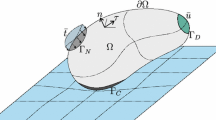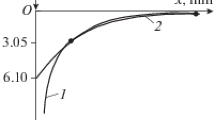Abstract
This investigation consists in finding stresses and displacements produced by a rigid footing (or punch) at the plane boundary of a semi-infinite elastic solid. The proposed method is a combined application of electrical analog and finite-difference technique and can be applied to any arbitrary shape of rigid footing (or punch). The experimental setup is very simple and the numerical-analysis part is easily amenable to computer programming. The method has been exemplified by 3 cases: (1) rigid strip footing (or punch); (2) rigid circular footing (or punch); and (3) rigid square footing (or punch) on a three-dimensional semi-infinite solid. The results, wherever possible, have been compared with exact solutions and have been found to be in close agreement.
Similar content being viewed by others
Abbreviations
- A :
-
some linear dimension of footing
- B :
-
half width of strip or half of side of square
- E :
-
modulus of elasticity
- a tog :
-
finite-difference-equation coefficients
- H :
-
nodal spacing
- l,m :
-
nodal-spacing coefficients
- q :
-
applied pressure
- R :
-
dimensionless distance from origin
- S :
-
summation of potentials
- u, v, w :
-
displacement components inx, y, z directions
- V :
-
inverse potential (nondimensional)
- w 0 :
-
depression under loading area
- x, y, z :
-
cartesian coordinates
- X, Y, Z :
-
nondimensional cartesian coordinates
- ζ:
-
depth variable
- γxy, γxz, γyz :
-
shear-strain components
- ε x , ε y , ε z :
-
unit elongation alongx, y, z directions
- ξ, η:
-
loading-area coordinates
- θ:
-
logarithmic potential
- ν:
-
Poisson's ratio
- σ x , σ y , σ z :
-
normal-stress components
- τ xy , τ yz , τ zx :
-
shear-stress components
- ψ:
-
nondimensional logarithmic potential
- ∇2 :
-
Laplacian operator
References
Todhunter, I. andPearson, K. A History of Theory of Elasticity and Strength of Materials,II (II),Dover Publication Inc.,New York (1960).
Shiffman, R. L. andAggarwal, B. D., “Stresses and Displacements Produced in a Semi-Infinite Elastic Solid by a Rigid Elleptical Footing,”Proceedings of 5th International Conference of Soil Mechanics and Foundation Engineering,I,795–801 (1961).
Prakash, I., “Analog-discrete Approach for Rigid-footing Problems,”M. Tech. Thesis, Department of Civil Engineering, Indian Institute of Technology, Kanpur, India (August 1971).
Scarborough, J. B., Numerical Mathematical Analysis, John Hopkins Press, Baltimore (1958).
Timoshenko, S. andGoodier, J. N., Theory of Elasticity, McGraw-Hill Book Co., Inc, Tokyo (1951).
Karplus, W. J. andSoroka, W. W., Analog Method Computation and Simulation, McGraw-Hill Book Co., Inc., New York (1959).
Author information
Authors and Affiliations
Rights and permissions
About this article
Cite this article
Kameswara Rao, N.S.V., Prakash, I. Analog-discrete approach for the solution of a class of rigid-contact problems. Experimental Mechanics 12, 564–569 (1972). https://doi.org/10.1007/BF02320600
Issue Date:
DOI: https://doi.org/10.1007/BF02320600




